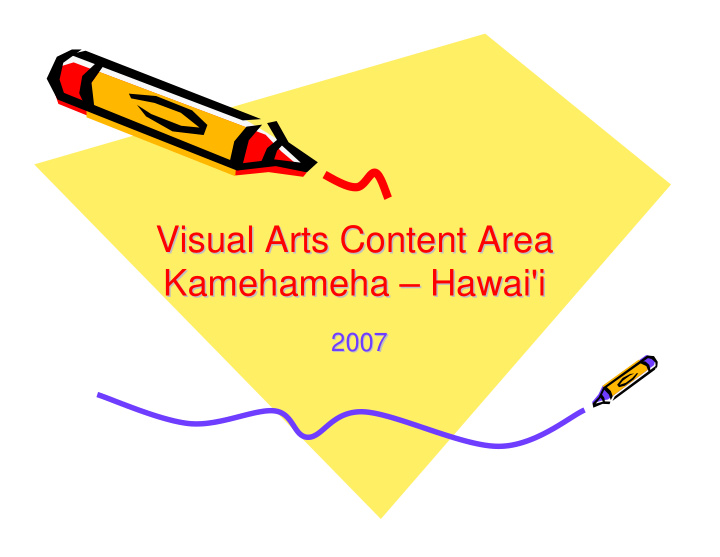



Visual Arts Content Area Visual Arts Content Area Kamehameha – – Hawai'i Hawai'i Kamehameha 2007 2007
Art Content Standard • CONTENT STANDARDS – 1. Understands and uses art materials, techniques, and processes in creating original artworks based on ideas, experiences, stories and opinions. – 2. Identifies, understands and applies the art elements and principles of design using the appropriate language of the visual arts. – 3. Identifies a wide range of subject matter, symbols, themes, metaphors and potential ideas throughout the history of art culminating in the contemporary. 4. Understands, identifies, and describes the relationship of the – visual arts to history and culture. – 5. Reflects upon the meaning and value of his/her own works and the works of others through description, analysis, interpretation and judgment. – 6. Makes connections between visual arts and other disciplines. – 7. Identifies and describes characteristics unique to both traditional and contemporary Hawaiian arts and crafts.
In Visual Arts Students need to… • Understand • Identify • Reflect • Make Connections
Art Content Standard #5 • Reflects upon the meaning and value of his\her own works of others through descriptions, analysis, interpretations and judgment.
Grade Level Benchmarks • Writes reflective entries (critiques, research papers, self-assessment and essay questions) that demonstrates student’s knowledge and comprehension of the content .
I Can Statements • I can write a reflection that shows I know what was created and how it was created, using specialized art vocabulary.
Evidence • Sample:
Procedures for Collecting Evidence • Administer writing prompts three times during the course (ex. semester/year) – Beginning, Middle and End • Complete peer reviews or oral critiques • Review analysis sheet and set aside time to fill out • Gather samples of work for various levels – Advanced, Proficient, Basic
Rubric
Anchor Pieces • Showing an examples of student samples advanced Vocabulary Connections QuickTime™ and a TIFF (Uncompressed) decompressor are needed to see this picture. Reflection
Examples of proficient student samples QuickTime™ and a TIFF (Uncompressed) decompressor are needed to see this picture. Vocabulary QuickTime™ and a TIFF (Uncompressed) decompressor are needed to see this picture. Connections Reflection
Bar Graphs SBCP Auli`i Nahulu-Kirsch Grade 7 Art 80.00% 70.37% Percent of Students 70.00% 60.00% 51.85% 50.00% 40.74% Baseline 40.00% Post 30.00% 22.22% 20.00% 7.41% 7.41% 10.00% 0.00% 0.00% 0.00% Below 2 3 to 4 5 to 6 7 to 8 Scores by Range Qualifying Score Baseline Post Below 2 22.22% 7.41% 3 to 4 70.37% 51.85% 5 to 6 7.41% 40.74% 7 to 8 0.00% 0.00%
Students’ Strengths and Weaknesses (post data collection) • Students are able to build upon art vocabulary to explain their art • Students need to focus more on personal meaning
Instructional Improvements • Explain on what we agree to focus on to see improvements. – TRY IT! • Everything is linked, so chunk it!! • How are we going to help the students improve – Word bank – More Peer- conferences to prep writing – Continue with deeper essay research to build references
Next Steps • Spiral progression to self directed analysis • Use of electronic portfolio for wide audience. • Continual refinement of critiques and modeling
Reflections • What are the school wide goals? – Are we going to continue each year with writing or are we moving into all disciplines? – Do we check back with the data to see if there is improvement and who will keep the recorded data? • How can we improve the quality of results & what does it really mean? – Are we looking for the personal growth in students or “Cookie cutter” reflections? • Is this the better way to support the students? – In-service training? • How if any, is my group contributing to the school wide goal?
Recommend
More recommend